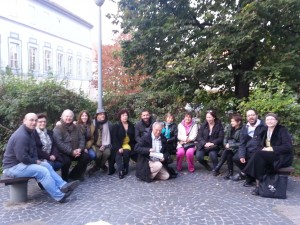The Alte Heim – Our Trip to Lithuania and Latvia
It is a week now since our Synagogue trip to Vilnius, Kaunas and Riga, three places that had such a rich Jewish story and that were so savagely cut down during the Holocaust. I had taken a number of trips to Poland, and so I basically wanted a change. I wanted to learn another great legendary Jewish story and also see how Jewish communities fared today in the Baltic States.
We were lucky to have two super guides, Regina in Lithuania, and Ilye in Riga who is Director of the Jewish Museum. Our trips, as I always like them to be, were split between learning about the past Jewish life, experiencing the present Jewish existence and learning about the experiences in the Holocaust. We also were lucky to see some of the beauty of the towns we visited – but in three days it is hard to see everything.
We started our trip with a reminder of the savagery of the Holocaust, by visiting Ponary forest outside Vilnius. Here is where the German Einsatzgruppen began killing the Jews of the Vilnius Ghetto in the second half of 1941. Remember that Germany and the Soviet Union agreed to split Poland between German and Soviet influence in August 1939 as part of the Molotov-Ribbentrop Pact. Germany invaded Poland and then soon after Soviets invaded Poland and annexed part of it as well as Lithuania and Latvia among other territories. So Jews either found themselves under German rule or Soviet rule. On June 21st 1941, the Germans reneged and invaded the Soviet Union in what was called Operation Barbarossa. Behind the German troops where special units who would take large numbers of Jews out of the towns and villages and kill them by shooting in nearby forest pits. So in Kaunas for instance, at a fort just outside it called the Ninth Fort, 20,000 Jews were killed there in 2 nights. This was the first step in the realisation of what would soon be officially called the Final Solution.
We visited a Museum of Tolerance in Vilnius, a fascinating museum with some wonderful art exhibits. There is also there the renovated Yiddish theatre from pre war Vilnius. We had a walking tour around Jewish Vilnius where we saw how important the Vilna Gaon was to the Jewish life of Lithuania. He was born in 1721 in Vilnius and lived most of the rest of the 18th century. He is considered one of the greatest of Jewish scholars and was also part of the vitriolic arguments that took place in the 18th century with the beginning of Chassidut. His grave was moved many years ago to the only remaining cemetery in Vilnius as were other great Rabbis. In fact we learned that the Soviets were responsible for the destruction of many gravesites after the second World War. Our guide even talked of ‘two Holocausts’ – one perpetrated by the Germans against Jews, and another by Soviets against Jews. I was not sure of this comparison, but it showed us how much contempt the Jewish community had for the past behavior of the Soviet Union against the Jewish populus.
In Kaunas, or Kovno as it was known as in Jewish circles, we visited the Jewish neighbourhood that was called Slobodka – it really still looks it would have done in the days of the Jewish shtetl life. It was a place of Jewish learning, yeshivot, and we saw the houses of some great Rabbis, such as Rabbi Yisrael Salanter. It was here that the Mussar movement was founded, which believed that those learning Torah should have a separate curriculum that works on ethics and character building. We then went on to the house of the Japanese war time ambassador to Vilnius, Chiune Sugihara who against the advice of his home government, wrote visas that allowed 6,000 Jews to escape to the east. His story is so inspiring – worth a look up on the internet if you don’t know of him already.
Riga was a magnificent city, home to streets of Art Nouveau architecture. We were toured around the Town centre and then went to the Jewish Museum, after which we saw the Riga ghetto for Jews in the war. Unlike in Poland and other parts of western Europe where Ghettos were in existence for longer, in Lithuania and Latvia, sometimes the ghettos were quick solutions for concentrating the Jews in order to kill them immediately. What was also disturbing was the amount of killing undertaken by locals before the German’s asserted their authority. This was especially worse in the Lithuanian towns. Riga was less of a learned town before the war, in fact our guide Ilya gave us the quote – ‘In Vilnius they learn, in Riga they earn’!
I should also mention that we did get some taste of present Jewish life. We all davenened with the minyan in the only remaining Vilnius Synagogue and I davened in the beautiful Riga Shul. We also saw the influence of Chabad on the communities there with restaurants and centres.
We finished at Rumbula forest, where the Jews of Riga were slaughtered. It had the most poignant, comforting memorial. You look at the memorial with your back to the filled in death pits. The memorial is a magen david of small tombstones with names on of people who died there. It even has symbolic streets fashioned in the memorial, with the stones themselves looking as though they have rooves as if to symbolise the houses they were taken from. Above stands a Menorah with roots directing into the ground as if to represent the old Latvian Jewish community, rooted in the soul of Latvia.
It was a sombre end to an enlightening, fascinating, inspiring and emotional trip back home – to the alte heim!

